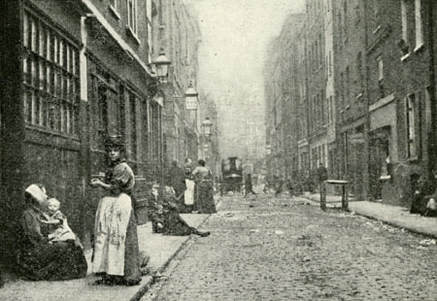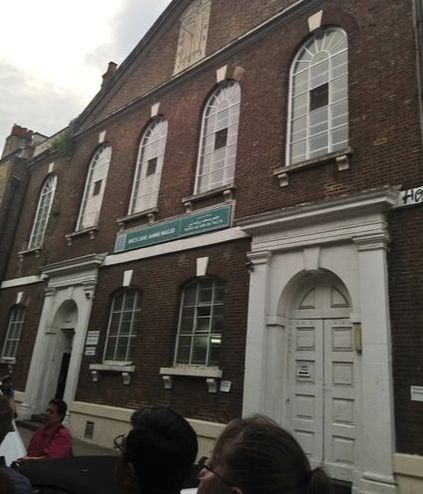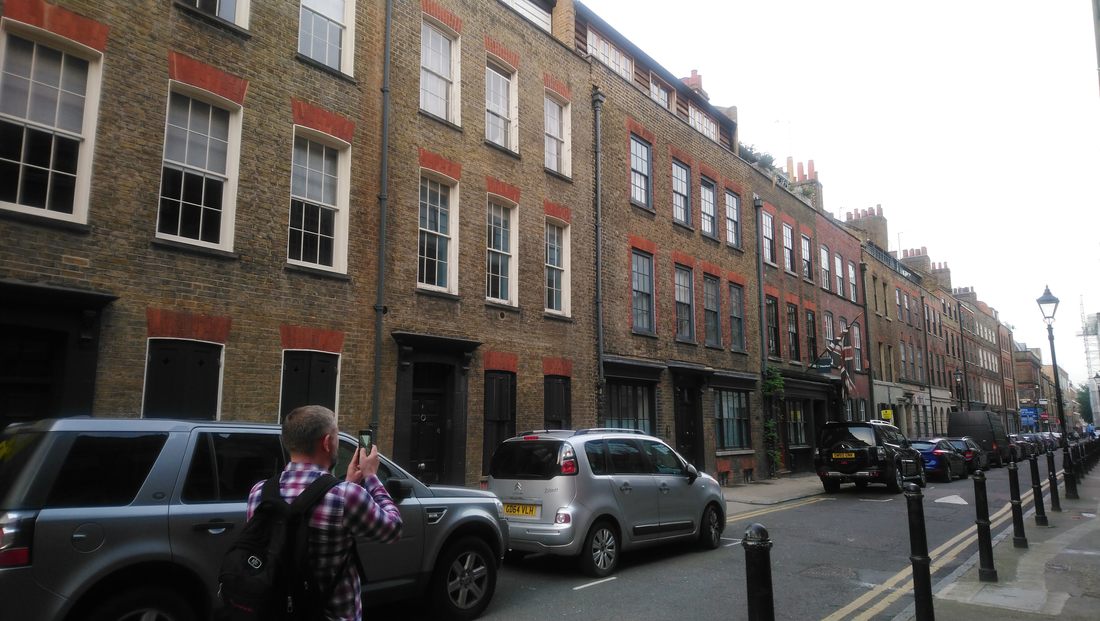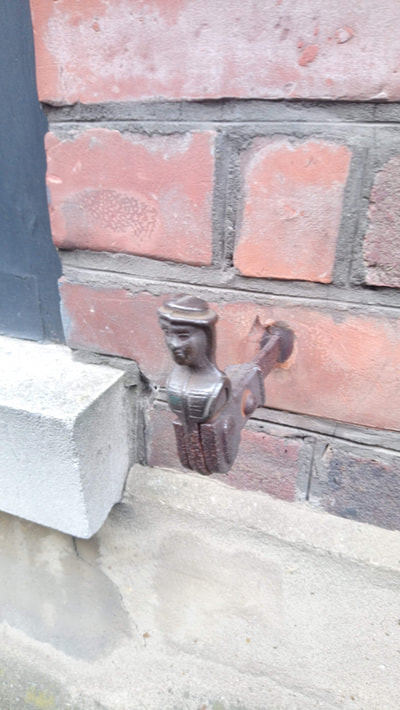|
Here's our tour guide. I never wrote down his name. He was great!
Our tour guide told us a lot about the history of Whitechapel. In 1888 Whitechapel was the poorest district in London and had the highest crime rate. It was so bad that Jack London went undercover to study its people, sleeping on the street or in a work house in order to experience for himself what conditions were like in the slum. His first hand account, The People of the Abyss, was published in 1903.
Here's a photo from the book.
The thing that most stood out to me from everything that our guide told us was what the prostitutes lives were like and the reasons that they all became prostitutes in the first place. Mary Nichols was married and had 5 children with her husband. She probably was a victim of postpartum depression which started her drinking and when it became so bad that she was a danger to the children, her husband kicked her out of the house. Eventually she wound up working as a prostitute. She was 43 .
Annie Chapman was married and had three children, but the eldest daughter died of meningitis and the youngest son was born a cripple and had to be institutionalized. At that point both parents began drinking heavily and Annie moved out. Her husband sent her money to support her, but when he died of cirrhosis of the liver, the money stopped. She moved in with a bricklayer, but he eventually left her. She asked her brother for money, but he only gave her two shillings. By Sept. of 1888 she was living in Whitechapel and working as a prostitute. She was 45. Elizabeth Stride was married and owned a coffee shop with her husband. Her husband became ill and died and she was left with nothing. She became a prostitute. She was 45. Mary Kelly's husband was killed in an mining explosion in Ireland. She moved to London's West End and worked in a high class brothel. She met a man and they moved in together, but when they split up, she eventually ended up in Whitechapel working as a prostitute again. She was 25. If there had been any kind of social services to help these poor women--counseling, therapy, support groups, anti-depressants--then maybe they wouldn't have turned to self-medicating with alcohol when their lives turned upside down. Even then, if there had been AA, maybe they wouldn't have had to turn tricks to buy the next bottle. It's a sad, sad story. However, publicity around the murders did one good thing. Because alcohol was considered the root of the problem (rather than the situations that had caused the reliance on alcohol) the temperance movement gained momentum and the Salvation Army stepped up to help rehabilitate the East End's "fallen women". The Salvation Army was also a big supporter of the Suffrage movement. The reasoning was that because a woman had no political power, a woman was at the mercy of her husband to care for her, and if he was a drunk she was beaten, if he was poor, she starved, if he was dead, she was out on the street. But if she could vote, she could help to enact laws that would prohibit drinking, close the brothels, and condemn all the Common Lodging Houses. Of course that took another thirty years, but I digress. More than just temperance, a variety of charities and other good works were started to help alleviate the plight of the poor in Whitechapel. One of them was the Whitechapel Gallery which opened in 1901 to help educate the local community. I just took a photo of the top of the building because the leaf detail was so interesting.
Our guide said that at the time Whitechapel had 8,530 residents. Of those, there were 1200 prostitutes living and working in the East End, 62 brothels, and only 233 Common Lodging Houses with a total of 6,000 beds. The lodging houses were owned by middle class men who didn't live in the area. They were managed by lower class men, usually criminal types, who didn't mind rousting the whores out of bed if they did't have their "doss" money, slang for sleep, So the rent per bed per night was anywhere from four to eight shillings. The prostitutes had to come home with at least this much money to get to sleep in a bed each night.
This video is from the same people who did the tour. It also talks about what conditions were like in Whitechapel at the time. Stops on the tour
Bucks Row - Mary Nichols
Hanbury Street - Annie Chapman Commercial Street Police Station The Ten Bells Pub The Royal London Hospital Working Lads Institute Gunthorpe Street Brick Lane, Osborne Street. Former Dorset Street The Happy Days Fish and Chip Shop The Former Berner Street Mitre Square Christ's Church Spitalfields
Christ's Church Spitalfields is the reason that Whitechapel is so named. It was built in 1729 to serve the increasing population in the area as London was expanding. It was built of white stone, thus people referred to it as the White Chapel which eventually came to mean the whole area. The courtyard was frequently a place that homeless people would spend the night when they didn't have their "doss money"--the 5 or 10 shillings paid to the landlords each night before they could sleep in a bed. Jack London frequently slept here when he was working on his book.
SPITALFIELDS Market
There had been a market on this site since 1638, but these buildings were freshly erected in 1887. The market is just across the street from Christ's Church.
Petticoat Lane
Here's a silent video of Petticoat Lane on a market day just 15 years after the Ripper murders. It's so weird to think that everyone in this film lived through the horror of that time
Here are the market stalls in Petticoat Lane today. The building now has rolling metal security doors for each stall, but it remains basically unchanged since 1888. Someone has painted a giant snake on all the doors.
Ten Bells Pub
The Ten Bells was built in 1752 and was the pub that the prostitutes did a lot of their drinking in. It was where Mary Kelly was last seen.
Ghoulston street
This is where the rest of Catherine Eddowes' apron was found as well as the graffiti done in chalk: "The Juwes are the men that will not be blamed for nothing". Although the police wiped it away, the doorway still has graffiti.
Brick Lane
This area was originally Gentile, but as the 18th century wore on, it became home to more and more Jews fleeing pogroms in Eastern Europe. By the time of the Ripper murders, this was a Jewish ghetto. When the infamous Goulston street graffiti was discovered it led to increased fear and racial animosity toward the immigrant population. This area is presently occupied by Middle Eastern people and many of the signs on the street are in Arabic.
There has been a church on Brick Street since 1745. Notice the date set in the sundial. At the beginning of the 1800's it was Methodist church, but by 1880 it had become a Jewish synagogue. In the 1970's it became a Mosque. Today it mostly serves Bangladeshi parishioners.
All the houses on Brick Lane are original Victorian construction. Other than the new paint on the windows and shutters, the outside of these flats are exactly they way they were in 1888. The city council wanted to knock them all down in the 1960's, but the historical society fought to save the buildings because they were landmarks. All of the apartments have since been remodeled inside as part of the gentrification of Whitechapel.
However, there is still one apartment left in Whitechapel that hasn't been remodeled or updated in any way since 1888. It was owned by two reclusive brothers who disappeared without any living relatives. The property was eventually sold to a guy who then didn't do anything to it. Instead, he rents it out for $800.00 a day to film crews. So, if you've seen Daniel Radcliffe's The Woman in Black, that 's the inside of his apartment at the beginning of the movie. Clearly the new owner hasn't even repainted the outside.
Buck's Row
Buck's Row was a mews, which is a stable. This is where Mary Nichols' body was found. Charlie Cross was leading his horse back to the stable at 3:30 am when the horse reared in panic and took off back down the street. Charlie chased after it, but he was old and tired and couldn't catch it, so he went back to the stable and that's when he found Mary's body. He thought his wife was playing a joke on him as this is something she'd done before. When he got closer to tell her to get up, he realized that it was not his wife, but a dead woman.
All the stables have since been turned into apartments and are occupied by Middle Eastern families. Thrawl Street
Mary Kelly was staying at a lodging house on Thrawl Street in 1887, but then moved to another lodging house on Dorset Street. Kelly was last seen here talking to a man before her body was found on Miller's Court the next day.This building on the corner of Brick Lane and Thrawl Street used to be a pub called Ye Frying Pan. Mary Ann Nichols lodged at no. 18 on Thrawl Street when she had her doss money. She had been drinking in Ye Frying Pan and was going back to her lodging house just down the street the night she was murdered. These days Ye Frying Pan is an Indian restaurant and hotel.
Hanbury Street
Annie Chapman had been drinking at the Ten Bells and was headed back to her lodging house when she was murdered. She was last seen outside of 29 Hanbury street talking to a man. Her body was found later that morning in the backyard of the flat. The site of no. 29 and the entire North side of the street was demolished in the 1960's and replaced by a brewery. This photo is of the south side of Hanberry which remains unchanged.
Art along the Route
Fun things that had nothing to do with the murder sites.
We picked up a flyer about this website while we were there. It's got even more information about the case and the history of Whitechapel.
The Map
We'd been in Kensington all day touring the Royal Albert Hall, Kensington Palace, and second trips to the V&A and the Natural History Museum. We took the Jubilee line from Kensington Station to Green Park and changed to the District line to Aldgate East Station. That's where the tour started. To get back to our hotel we took the tube back from Aldgate East Station to King's Cross and then changed to the Picadilly line and rode back to Covent Garden.
0 Comments
Leave a Reply. |
CategoriesArchives
July 2024
|























 RSS Feed
RSS Feed